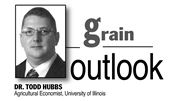|
2017 Soybean Prospects

As we approach the midway point of the 2016-17 marketing year, planting and new crop marketing decisions are being made for the next marketing year. This is the time of year to discuss 2017-18 soybean marketing year prospects. The development of soybean prices over the next year depends on the prospective size of the 2017 U.S. crop and the prospects for stocks at the end of the 2016-17 marketing year.
Soybean prices have remained relatively high despite large U.S. and world soybean supplies. On February 9, the latest release of USDA projections for the 2016-17 marketing year maintained the balance sheet numbers from the previous month. At 420 million bushels, forecast stocks of U.S. soybeans at the end of the current marketing year represent the highest ending stocks estimation since the 2006-07 marketing year. Additionally, the current projection for South American soybean production is at 6.374 billion bushels. The prospect of 2016-17 marketing year ending stocks decreasing over the remainder of the marketing year is dependent on strong export numbers. Increased export potential is contingent on the soybean crops currently produced in Brazil and Argentina. While the possibility of surpassing the 2.05 billion bushel USDA export projection for soybeans exists, the caution exhibited by the USDA in maintaining the export number at its current level is warranted.
Building expectations about the 2017 U.S. soybean production prospects begin with planted acreage. Current expectations for soybean planted acreage encompass a wide range of possibilities. Some observers place planted acreage levels at 89 million acres or greater. U.S. soybean plantings in 2016 came in at a record 83.4 million acres, which were a 700 thousand acre increase over 2015 and slightly above the 83.3 million acres planted in 2014. Congressional Budget Office (CBO) projections for baseline farm programs released last month set planted acreage at 86.5 million acres. Current USDA long-term baseline projections have 2017 planted acreage at 85.5 million acres. Multiple factors currently drive the expectation of a large increase in soybean acreage. Hard red winter wheat seedings are down 3.7 million acres. A reduction in soft spring wheat acreage is also possible, and that releases additional acreage for spring-planted crops. The lower cost of producing soybeans relative to corn and the perceived price advantage of soybeans over corn drive expectations of an acreage shift from corn to soybeans. The price advantage of soybeans relative to corn maintains a strong soybean position as the current ratio of November soybean futures to December corn futures above 2.5.
Given the number of factors pointing toward greater soybean planted acreage in 2017, planted acreage near 87.4 million is a reasonable expectation. Since 1996, an increase in soybean planted acreage exceeded four million acres three times. While the possibility exists for a six to seven million acre increase in soybean acreage this year, it would be one of the largest shifts in soybean planted acreage on the historical record. The USDA will survey producer's planting intentions next month and release an estimate of those intentions in the March 31 Prospective Plantings report. Further clarification on the planted acreage in soybeans will be provided by the June USDA Acreage report.
Since the start of the freedom to farm era in 1996, the difference between planted and harvested acreage of soybeans ranged between 595 thousand to 1.858 million acres and averaged 1.03 million acres. Years of drought accounted for large differences. Under a normal weather scenario, the record level of planted acreage may see the abandonment of approximately 700 thousand acres in 2017. Planted acreage of 87.4 million acres leads to a harvested acreage of about 84.7 million acres.
Yield expectations for the next crop year normally rely on trend yield analysis. Three successive years of soybean yields well above trend culminated with 52.1 bushels per acre in 2016. It is difficult to determine if the recent increase in soybean yields is the beginning of a new production era. For now, we will continue with the basic trend expectations. Current USDA baseline projections place 2017 soybean yields at 47.9 bushels per acre. CBO projections come in at 47 bushels per acre. Based on the growth in soybean yields in the last three years, normal weather during 2017 could provide an average U.S. soybean yield near 48 bushels per acre. Yield at that level would create a 2017 soybean crop of 4.162 billion bushels, 145 million bushels smaller than the 2016 crop.
A 2017 soybean crop of 4.162 billion bushels combined with the current USDA soybean stock projection of 420 million bushels and imports of 25 million bushels leads to a marketing year supply of 4.601 billion bushels, 73 million bushels larger than the supply for the current year. To prevent 2017-18 ending stocks from increasing under this scenario, soybean consumption needs to greater than 4.181 billion bushels, 73 million bushels greater than current 2016-17 marketing year projections. Increased soybean consumption at this level does not seem likely under current demand scenarios.
Expectations for the 2017-18 marketing year include increased acreage, an increase in ending stocks, and lower prices when compared to the current marketing year. The mitigation of a major price decline requires a reduction in 2016-17 ending stocks from the current 420 million bushels or lower production in 2017. The scenario discussed places average farm prices for soybeans in a range of $8.90 - $9.10 for the 2017-18 marketing year. ∆
DR. TODD HUBBS: Agricultural Economist, University of Illinois
|
|